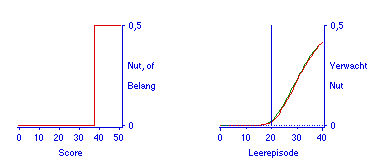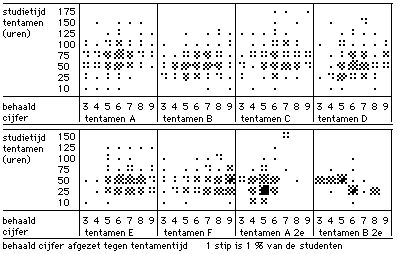Literatuur over examenregelingen
Ben Wilbrink
Zie ook zittenblijven.htm
Zie ook cijfergeven.htm
Zie ook cesuurbepaling.htm
Zie ook examens.htm
Niets nieuws onder de zonIn den aanvang toch werd tusschen alle vakken compensatie aangenomen; later werd voor de hoofd- en hulpacten gevorderd , dat de candidaat niet slechts in alle vakken te zamen , maar bovendien in de Nederlandsche taal en in het rekenen te zamen , één goedkeuringsteeken meer zou verkregen hebben dan de helft van het maximum der teekens die konden behaald worden.
Bij het laatst afgenomen examen eindelijk is voor hoofd- en hulponderwijzers en onderwijzeressen de eisch gesteld , dat zij èn in de taal èn in het rekenen afzonderlijk, èn in de overige vakken te zamen één teeken meer dan de helft van het maximum hadden verkregen , terwijl voor de vakken van het meer uitgebreid lager onderwijs drie vierde deelen van dat maximum , voor al de onderdeelen van het programma te zamen genomen , gevorderd zijn.
Verslag van den Staat der Hooge-, Middelbare en Lagere scholen over 1864/1865 (Bijlagen van het Regeringsverslag) vel 4013 16049 Tweede Kamer
Ben Wilbrink: Strategic Preparation for Achievement Tests (project)
start page
The model to be developed here makes the most of what Cronbach and Gleser (1957) called the individual point of view in testing, as contrasted to the institutional one. I need not explain that mainstream psychometrics, as applied in educational assessment, is especially concerned with testing as instrumental in institutional decision-making—such as admissions, examinations—or even political decision-making—such as following from the (U.S.) No Child Left behind Act. The suggestion that students might be decision-makers also, in the sense of students strategically preparing for their tests, is seldom heard of. Bob van Naerssen (1970
html) probably has been the first to articulate a model for this kind of strategic behavior. The most significant application of this kind of model is in the quantitative evaluation of the qualities of asssessments and examinations, making it possible to develop variants of assessment procedures that are less wasteful of the time of students and of the time of staff as well. The analogy here is to that of the effects of personnel selection using the decision-theoretic approach advocated by Cronbach and Gleser (for example, see my 1990
pdf simulation of complex selection procedures for techniques as well as for the literature)
abstract

Ben Wilbrink (1995). Studiestrategieën die voor studenten èn docenten optimaal zijn: het sturen van investeringen in de studie. Korte versie in Bert Creemers e.a. (Red.), Onderwijsonderzoek in Nederland en Vlaanderen 1995. Proceedings van de Onderwijs Research Dagen 1995 te Groningen (218-220). Groningen: GION. Paper: auteur
abstract
- Op basis van de beginselen achter het tentamenmodel van Van Naerssen (1970) is het mogelijk gebleken een Algemeen Toetsmodel (ATM) te ontwikkelen waarmee ook complexere examenregelingen zijn te analyseren (dit ATM is beschreven in een parallelpaper in de sectie methodologie). Een interessant casus voor zo’n analyse is de ontwikkeling in de numerieke rendementen van de propedeuse geneeskunde in Groningen, zoals beschreven door Janke Cohen-Schotanus (1994).
- In dit paper komt een jaren later pas gecorrigeerde misvatting over de constructie van nutsfuncties bij compensatie voor. Hoewel de juiste techniek anno 2003 nog niet is gepubliceerd, is in de geactualiseerde versie van dit paper ook de gecorrigeerde analyse opgenomen: deze leidt tot nog duidelijker aan compensatie toe te schrijven voordelen.
- De analyse van een casus met vrijstellende deeltoetsen heeft een corollary die in 1995 over het hoofd is gezien: als toetsen op deze wijze modelmatig uiteen zijn te leggen in deeltoetsen, moet het Algemene Toetsmodel ook geldigheid hebben in situaties waarin er vooral sprake is van begeleiding van de student (formatieve toetsing), en minder van een eindbeoordeling (summatieve toetsing). Het ATM is daarom niet inherent gebonden aan of beperkt tot formele toetsmomenten.
Cohen-Schotanus, J. (1994).
Effecten van curriculumveranderingen. Studiewaardering, studeergedrag, kennis, studiedoorstroom in een veranderend medisch curriculum. Proefschrift Rijksuniversiteit Groningen.
Coleman, J. S. (1990). Foundations of social theory. Belknap.
Hofstee, W. K. B. (1987). Kort extern advies. Groningen. (niet gepubliceerd)
Lord, F. M. (1962). Cutting scores and errors of measurement. Psychometrika, 27, 19-30.
Lord, F. M. (1963). Cutting scores and errors of measurement - a second case. Educational and Psychological Measurement, 23, 63-69.
Naerssen, R. F. van (1970). Over optimaal studeren en tentamens combineren. Openbare les. Amsterdam: Swets & Zeitlinger. html
Rekveld, I. J., Starren, J. (1994). Een examenregeling zonder compensatie in het Nederlandse Hoger Onderwijs? Een vergelijking tussen compensatie en conjunctie. [Heymans Bulletins, HB-94-1150-SW, met bijlagen, o.a. opmerkingen van expert-panelleden Hofstee, de Gruijter, Cohen-Schotnus en Wilbrink] Tijdschrift voor Hoger Onderwijs, 12, 210-219. pdf
Schouwenburg, H. (1994): Uitstelgedrag bij studenten. Proefschrift Rijksuniversiteit Groningen.
Wilbrink, B. (1995). Van Naerssen's tentamenmodel in algemene vorm. In B. Creemers e.a. (1995). Onderwijsonderzoek in Nederland en Vlaanderen 1995. Proceedings van de Onderwijs Research Dagen 1995 te Groningen. Groningen: GION. 114-115. Paper: auteur. html

Ben Wilbrink (1995). Van Naerssen's tentamenmodel in algemene vorm. Korte versie in B. Creemers e.a. (1995). Onderwijsonderzoek in Nederland en Vlaanderen 1995. Proceedings van de Onderwijs Research Dagen 1995 te Groningen. Groningen: GION. 114-115. Paper: auteur. html
- In 1970 presenteerde Van Naerssen zijn tentamenmodel, dat de belofte in zich droeg een instrument te worden om studeergedrag te kunnen verklaren als afhankelijk van de toets(situatie), en en om toetsen en examens zo te kunnen inrichten dat deze met een minimum aan verliestijden zijn te behalen. Dit tentamenmodel is een van de de eerste pogingen om beoordelen in het onderwijs te modelleren als een proces van keuzen van zowel studenten als docenten, met technieken uit de economische besliskunde. De uitdaging is nu om dit tentamenmodel verder te ontwikkelen tot een algemeen toetsmodel (ATM) zodat het ook in andere situaties is te gebruiken, en om het te verbinden met de micro-economische theorie en ColemanÕs (1990) theorie van sociale systemen.
- Coleman, J. S. (1990). Foundations of social theory. London: Belknap.
- Cronbach, L. J., & Gleser, G. C. (1965). Psychological tests and personnel decisions. Urbana: University of Illionois Press.
Ben Wilbrink (1992). Modelling the connection between individual behaviour and macro-level outputs. Understanding grade retention, drop-out and study-delays as system rigidities. In Tj. Plomp, J. M. Pieters & A. Feteris (Eds.), European Conference on Educational Research (pp. 701-704.). Enschede: University of Twente. Paper: auteur. html
- Certain anomalies in education are extremely resistant to change, as is certainly the case for grade retention in secondary education and for attrition and study-delay in higher education. Present-day research methodology and data analysis in the educational field are not fit to the task to elucidate this kind of macro-educational phenomena. Recently Coleman (1990, Foundations of social theory. Cambridge, Massachusetts) presented a theory of social systems that connects behavior of actors (for example students and teachers) at the micro-level with phenomena occurring at the macro-level of the social system involved. The theory of Coleman has its roots in micro-economics, and is conceptually very different from traditional methodological approaches to social (and educational) phenomena. The paper explores the possibility to apply this theory to the mentioned problems in education, using empirical data (grades and time expenditure) from the first year examinations 1985-1989 of the study of law at the University of Amsterdam.
-
See the response of James Coleman attached to 92ColemanApplicationECER.htm. For the Pascal program: contact me.

Ben Wilbrink (1992). The first year examination as negotiation; an application of Coleman's social system theory to law education data. In Tj. Plomp, J. M. Pieters & A. Feteris (Eds.), European Conference on Educational Research (pp. 1149-1152). Enschede: University of Twente. Paper: auteur. htm
The question asked, and answered in the paper, is how it is possible to describe self-study and examination results in the first year examination in such a way as to get a handle on the process. Marks and time spent for all parts of the first year examination in law at the University of Amsterdam, over a number of years, are the data that are available. The question is not whether time spent is related to marks received: of course it is. The real question is why so little time (appr. 800 hours) is spent, and yet so many unsatisfactory marks are received. This educational system must be constituted in such a way that it is NOT rational for students to invest a little extra time and succeed for the examination within the time limit of one year, for they are not behaving that way. These data are eminently suited to apply techniques of Coleman's (1990) social system theory, to reveal the weak spots in this educational system, and to suggest policy measures to repair them.
Added to the file; letter to James Coleman, and his return letter. For the data and the Pascal program: contact me.

Marjon Voorthuis en Ben Wilbrink (1987). Studielast, rendement en functies propedeuse. Relaties tussen wetgeving, theorie en empirie. Deelrapport 2: Evaluatie-onderzoek Wet Twee-fasenstructuur. Amsterdam: SCO-rapport 112. html

Ben Wilbrink (1979). Toetsen, herkansen, studievertraging: Achterliggende mechanismen. Onderzoek van Onderwijs, 9, juni, 7-11.
html
Cohen-Schotanus, J., en T. Mooiweer. Hoe langer hoe beter. De relatie tussen voorbereidingstijd en tentamenresultaat bij medisch studenten te Groningen. Paper Onderwijs Research Dagen 1979. Buro Onderwijs Ontwikkeling Geneeskunde, Groningen. [heb ik dat paper nog?]
abstract
Han Starren (1989). Optimaliseren van leerresultaten via veranderen van examenregels. Heymans Bulletin Psychologische Instituten R. U. Gronignen HB_89_**_IN
abstract
D. N. M. de Gruijter (1990). De propedeutische examenregeling. Bureau Onderzoek van Onderwijs Rijksuniversiteit Leiden Memorandum 1035-90.
abstract
M. J. Cresswell (1987). A more generally useful measure of the weight of examination components. British Journal of Mathematical and Statistical Psychology, 40, 61079
abstract [JSTOR, free online, bij registratie]
abstract
 http://www.benwilbrink.nl/literature/examenregelingen.htm
http://goo.gl/YqURE
http://www.benwilbrink.nl/literature/examenregelingen.htm
http://goo.gl/YqURE





![]() http://www.benwilbrink.nl/literature/examenregelingen.htm
http://goo.gl/YqURE
http://www.benwilbrink.nl/literature/examenregelingen.htm
http://goo.gl/YqURE